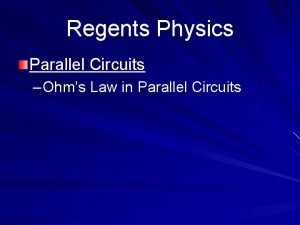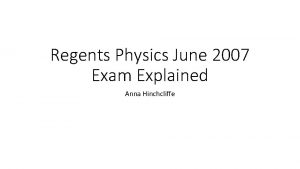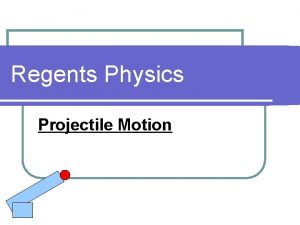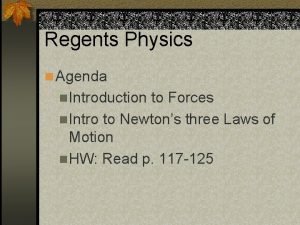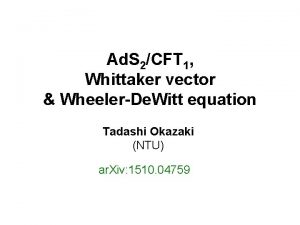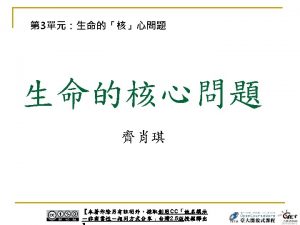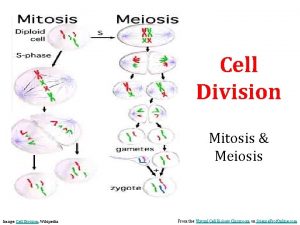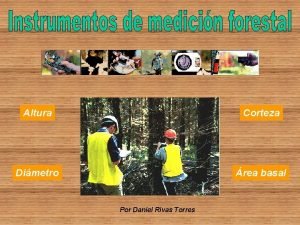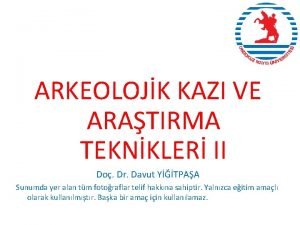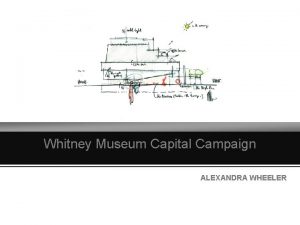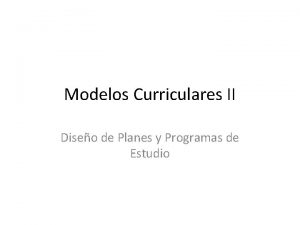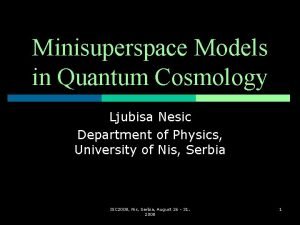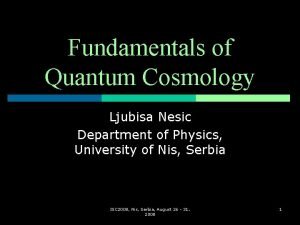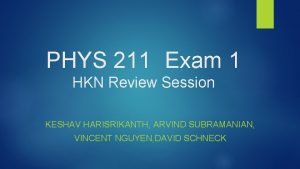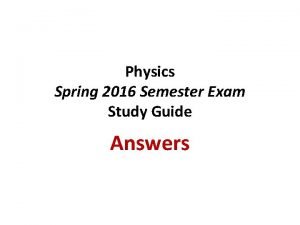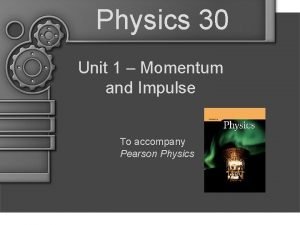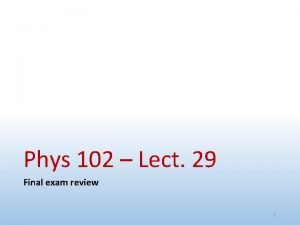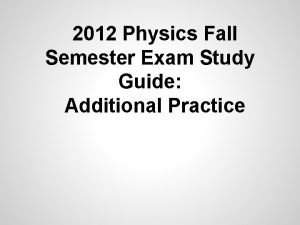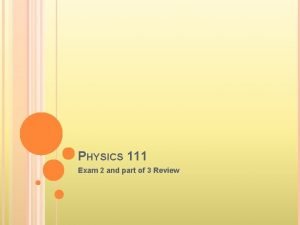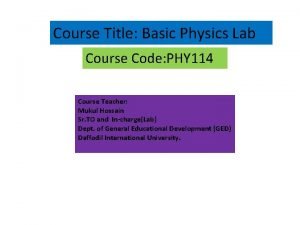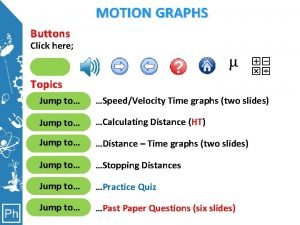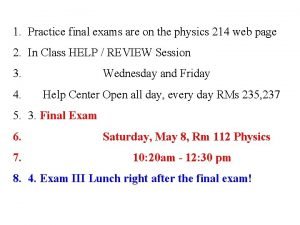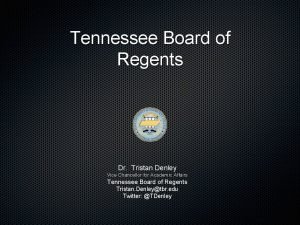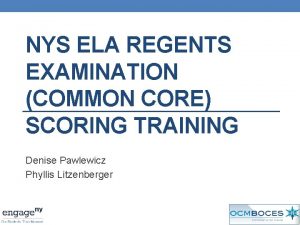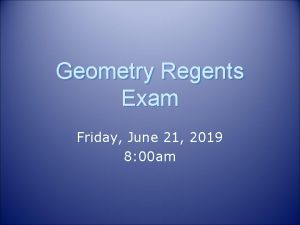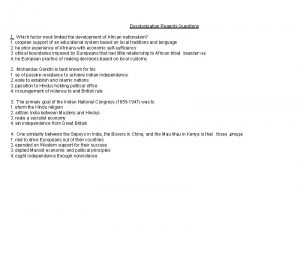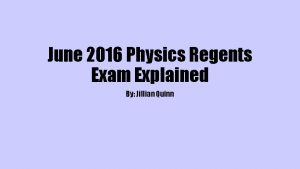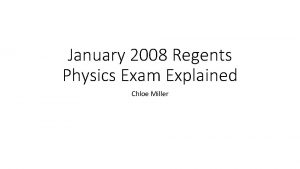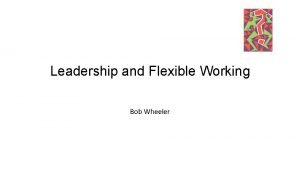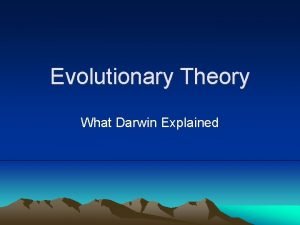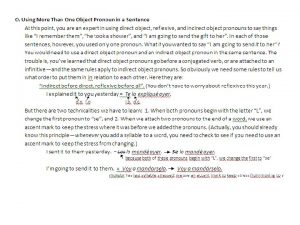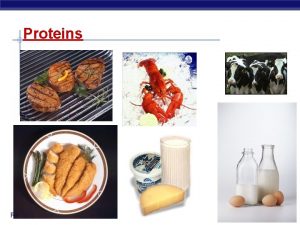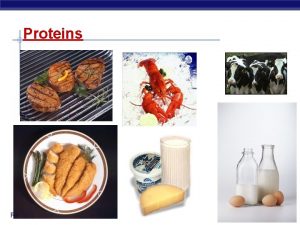Jan 2003 Regents Physics Exam Explained James Wheeler













































































- Slides: 77

Jan 2003 Regents Physics Exam Explained James Wheeler

1) The worker exhibits a force with both magnitude and direction.

2) d = 90 m - 40 m = 50 m t = 20 s v=? v = d/t v = 50 m/20 s v = 2. 5 m/s

3) t = 3 s a = 9. 81 m/s 2 vi = 0 m/s d=? d = vit + (1/2)at 2 d = (0)(3 s) + (. 5)9. 81(3)2 d = 0 + (. 5)9. 81(9) d = 44. 145 m

4) Newton’s First law states that if any object is at rest or moving at a constant speed in a straight line, it will remain at rest or keep moving in a straight line at constant speed unless it is acted upon by a force.

5) F 2 = 10 N a 1 = 5 m/s 2 m=? F = ma F/a= m m =(10 N)/(5 m/s 2) m = 2 g a 2 = 1 m/s 2 F 2= ? F 2=ma F 2 = (2 g)(1 m/s 2) F 2 = 2 N

6) g = Fg/m rise/run

7) m = 1200 kg v = 10 m/s t =. 1 s F=? F = ma F = m/(v/t) F= 1200 kg(10 m/s /. 1 s) F = 120, 000 N

8)

9) v = 12 m /s r = 30 m ac = v 2/r ac = (12 m/s)2/(30 m) ac = (144 m/s)/(30 m) ac = 4. 8 m/s 2

10) Centripetal acceleration is always towards the center. If it helps, remember that centripetal in Latin means “center seeking”.

11) μ = Ff/Fn Neither the force of friction or the normal force change which means that the coefficient of friction(μ) stays the same.

12) W = Fd Displacement(d) is a factor when it comes to work(W).

13) 3 m/s A p = mv p. A=p. B m Av A = m B v B (1. 2 kg)(v. A) = (1. 8 kg)(2 m/s) (1. 2 kg)(v. A) = 3. 6 v. A = 3 m/s B

14)

15) Δh =. 22 m mg = 15 N ΔPE= mgΔh ΔPE= (15 N)(. 22 m) ΔPE= 3. 3 J

16) KE = (1/2)mv 2 As an object is in freefall it accelerates, increasing its velocity and therefore increasing its kinetic energy.

17) q = 2. 5 x 10 -6 C W = 6. 3 x 10 -4 J V = W/q V = (6. 3 x 10 -4 J)/(2. 5 x 10 -6) V = 2. 5 x 102

18) F = 12 N v = (8 m)/(2 s) v = 4 m/s P = Fv P = (12 N)(4 m/s) P = 48 W

19) Opposite charges attract, like charges repel.

20) Fe= (kq 1 q 2)/r 2 As shown by the equation for electrostatic force, as the radius increases, the electrostatic force decreases exponentially.

21) Because the rod is positively charged, it wants to gain electrons, so it takes some from the neutral sphere.

22) Δq = 10 C T=5 s I = Δq/t I = (10 C)/(5 s) I=2 A

23) If the plates are parallel, then each point will experience the same magnetic field strength.

24) *Periodic waves transfer energy only.

25) P = VI As voltage(V) increases, power(P) increases as well.

26) v = 120 V I = 10 A t = 30 s W=? W = VIt W = (120 V)(10 A)(30 s) W = 36000 J W = 3. 6 x 104

27) Frequency(f): the # of cycles per second (Hz) 4/1 s = 4 Hz

28) The same point on each respective pulse A periodic wave is a series of pulses that are evenly timed.


30) f = 5. 09 x 1014 v = 2. 25 x 108 We must calculate the absolute index of refraction(n) n = c/v n = (3 x 108)/(2. 25 x 108) n = 1. 33

31) f = 5. 0 x 1014 c = 3 x 108 λ=? λ = v/f λ = (3 x 108)/(5. 0 x 1014) λ = 6 x 10 -7

32) The Doppler effect represents the relative change in frequency that is a result of a moving source of a wave.

33) A node is a point of zero displacement when two waves interact zero displacement

34) 1 e. V = 1. 6 x 10 -19 (1. 6 x 10 -19)(6. 0 x 106) 9. 6 x 10 -13

35) P = W/t P = J/s

Resultants:

a ay ax decreases ay increases θ ax

2. 2 Ib 2204. Ib

ET= PE + KE + Q ΔPE = mgΔh There is no change in potential energy because the track is purely horizontal, meaning there is no change in height(h). KE = (1/2)mv 2 There is no change in kinetic energy because the block is traveling at a constant velocity(v). There can be a change in internal energy(Q) only.

Utilize the electromagnetic spectrum in your reference table. X rays have the greatest frequency of all the options, and since there is a direct relationship between frequency and energy, X rays is the answer.

Since the energy in this system is purely potential, we can just calculate the total amount of work. d =. 5 m W = Fd F = 15 N W = (15 N)(. 5 m) W = 7. 5 J

Remember ohm’s law R=V/I (V) (I) Now that we know this graph measures resistance (R), and since a greater temperature means greater resistance, we know the answer should represent an increase in resistance.

Series Circuits I = I 1 = I 2 Req = R 1 + R 2 V = V 1+V 2 Req = 8 ohms + 8 ohms Req = 16 ohms V= 12 v I=? I= V/R I= 12 v/16 ohms I =. 75 A

The needle of a compass follows the magnetic field lines, which always travel from north to south.

The object is stationary v = d/t Constant velocity The object has a constant velocity, and then instantly decelerates. a = Δv/t Displacement grows exponentially as time increases.

Pes = (1/2)kx 2 2(Pes)/x 2 = k A B 2(Pes)/x 2 = k 2(. 4 N)/(. 04 m) 2(. 6 N)/(. 04 m) 20 = k 30 = k

Remember the law of conservation of charge 4 A - 1 A = 2 A 2 A – 1 A = 1 A 3 A – 2 A = 1 A

Check reference book for absolute indices. n 1 sin θ 1 = n 2 sin θ 2 (1)(sin 30) = (1. 5)(sin θ 2). 5 = 1. 5(sinθ 2). 333=sinθ 2

Medium Y, because according to the diagram it’s the densest medium, meaning that light travels the slowest in medium Y.

Superposition- the combined displacement of the two interfering waves is the algebraic sum.

v =19. 8 m/s θ = 30° /s m. 8 19 vy 30° vx sin 30° = vy/(19. 8 m/s). 5 =vy/(19. 8 m/s). 5(19. 8 m/s) = vy 9. 8 m/s = vy

a = -9. 81 m/s 2 a = Δv/t t = Δv/a t = (-9. 8 m/s – 9. 8 m/s)/ )/(-9. 81 m/s 2) t = (-19. 6 m/s)/(-9. 81 m/s 2) t=2 s

Voltmeters require a parallel connection V

The resistors are connected in parallel 1/Req = 1/4 Ω + 1/6 Ω 1/Req = 5/12 Ω Req = 2. 4 Ω

*Diffraction, is the spreading out of a wave into a region beyond an obstacle.

The strong force, or the strong nuclear force prevents the nucleus of a helium atom from flying apart.

L=1 m ρ(reference book) = 150. x 10 -8 A = 7. 85 x 10 -7 R = ρL/A R = (150 x 10 -8 Ωm)(1 m)/(7. 85 x 10 -7) R = 1. 91 Ω

R = 1. 91 Ω V = 1. 5 V I=? Ohm’s law I = (1. 5 V)/(1. 91 Ω) I =. 785 A


59 -61 62)

B, because the mass has the greatest velocity, where as the velocity at both point A and C would be 0.

A, because the height(h) is greatest.

Point C, because the change in length from the equilibrium position of the spring(x) is the greatest at point C.

6. 0 x 10 -15 N 8. 0 x 10 -15 N *always include arrowheads

6. 0 x 10 -15 N 8. 0 x 10 -15 N 10 cm

6. 0 x 10 -15 N 8. 0 x 10 -15 N 10 cm

6. 0 x 10 -15 N 8. 0 x 10 -15 N 10 cm θ 10 6 8

*check your reference table for coefficient of friction FN = 25 N =. 3 Ff = ?

Fn = 25 N Fg = 25 N

Fn = 25 N Ff = 7. 5 N Fa = 10 N Fg = 25 N

F = Fa – Ff F = 10 N – 7. 5 N F =2. 5 N Fn = 25 N Ff = 7. 5 N Fa = 10 N Fg = 25 N

Yes, the crate is accelerating because it is not in equilibrium and there is a net force acting on it. Fn = 25 N Ff = 7. 5 N Fa = 10 N Fg = 25 N

*Check your reference table Ei = -1. 51 e. V Ef = -3. 40 e. V Ephoton = Ei – Ef Ephoton = -1. 51 e. V – (-3. 40 e. V) Ephoton = 1. 89 e. V

Ephoton = 1. 89 e. V 1 e. V = 1. 6 x 10 -19 J Ephoton = (1. 89)(1. 6 x 10 -19) Ephoton = 3. 024 x 10 -19 J

E = 3. 024 x 10 -19 J f=?

or
 January 25 2018 chemistry regents answers
January 25 2018 chemistry regents answers Internal resistance
Internal resistance Regents physics work power energy
Regents physics work power energy June 2007 physics regents answers
June 2007 physics regents answers Work and energy
Work and energy Regents physics projectile motion questions
Regents physics projectile motion questions What is inertia
What is inertia The trailside killer
The trailside killer James russell odom and james clayton lawson
James russell odom and james clayton lawson Conception of curriculum
Conception of curriculum Sir mortimer wheeler scientific and soil layer method
Sir mortimer wheeler scientific and soil layer method Christa wheeler
Christa wheeler Pentaprisma de wheeler
Pentaprisma de wheeler Bob wheeler tool time
Bob wheeler tool time Colonel john wheeler
Colonel john wheeler Whittaker modificado
Whittaker modificado Jean wheeler
Jean wheeler How to calculate the total surface area
How to calculate the total surface area Brenna wheeler
Brenna wheeler Richard wheeler
Richard wheeler Pentaprisma de wheeler
Pentaprisma de wheeler Richard wheeler
Richard wheeler Mitosis
Mitosis Cosette wheeler
Cosette wheeler Wheeler kutu plankaresi
Wheeler kutu plankaresi Alexandra wheeler
Alexandra wheeler Modelo curricular de wheeler
Modelo curricular de wheeler Wheeler dewitt equation
Wheeler dewitt equation Herbert wheeler
Herbert wheeler Wheeler dewitt equation
Wheeler dewitt equation Colleen wheeler
Colleen wheeler Brenna wheeler
Brenna wheeler Physics 211 exam 1
Physics 211 exam 1 Physics semester 1 final exam study guide answers
Physics semester 1 final exam study guide answers Physics fall final exam review
Physics fall final exam review Momentum and impulse physics 30
Momentum and impulse physics 30 Physics 102 final exam
Physics 102 final exam Physics fall semester exam review
Physics fall semester exam review Physics 1 exam 2 review
Physics 1 exam 2 review Physics exam 2 review
Physics exam 2 review Physics 111 exam 1
Physics 111 exam 1 Physics 1 lab final exam
Physics 1 lab final exam Horizonal
Horizonal Milgrims experiment
Milgrims experiment Physics 101 final exam
Physics 101 final exam Why does it happen
Why does it happen University physics with modern physics fifteenth edition
University physics with modern physics fifteenth edition Physics ia exemplars
Physics ia exemplars Us history regents review
Us history regents review Which map shows the most probable areas of precipitation
Which map shows the most probable areas of precipitation Periodic table regents
Periodic table regents Tristan denley louisiana board of regents
Tristan denley louisiana board of regents Beaks of finches lab answers
Beaks of finches lab answers Earth science lab practical review
Earth science lab practical review Regents
Regents Chemistry regents 2011
Chemistry regents 2011 English regents text analysis
English regents text analysis Chemistry regents conversion chart
Chemistry regents conversion chart Louisiana board of regents
Louisiana board of regents Earth science regents part d
Earth science regents part d Earth science regents lab practical
Earth science regents lab practical June 2010 chemistry regents
June 2010 chemistry regents Kent chemistry reference table
Kent chemistry reference table Nysedregents chemistry
Nysedregents chemistry Uc regents policy 5402
Uc regents policy 5402 Middle ages regents questions
Middle ages regents questions The justinian code is considered a milestone because it
The justinian code is considered a milestone because it June 21 2019 geometry regents answers
June 21 2019 geometry regents answers Decolonization regents questions
Decolonization regents questions Crq global regents
Crq global regents Energy flow trophic levels
Energy flow trophic levels 282 ways to pass the earth science regents
282 ways to pass the earth science regents Us history regents practice
Us history regents practice Thematic essay human rights
Thematic essay human rights Table g chemistry
Table g chemistry United states history and government regents
United states history and government regents Regents chemistry midterm
Regents chemistry midterm Chemistry bonding regents questions
Chemistry bonding regents questions

